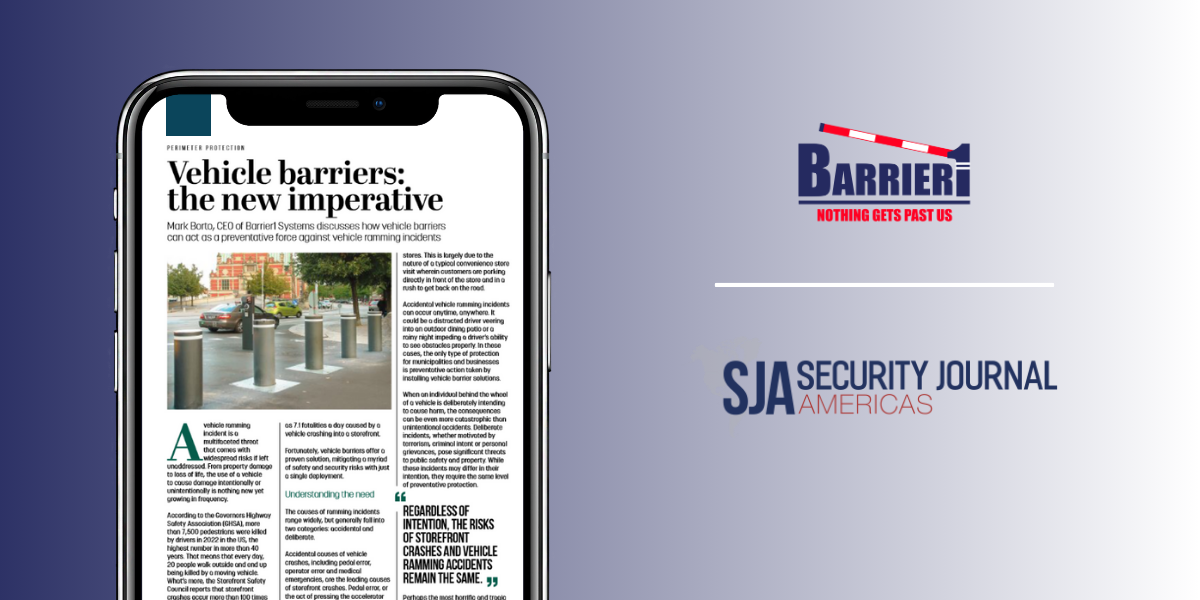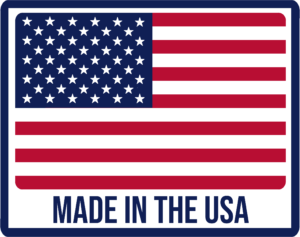
Vehicle Barriers:
The New Imperative
Mark Borto, CEO of Barrier1 Systems discusses how vehicle barriers can act as a preventative force against vehicle ramming incidents
When making a list of physical safety and security threats that require a solution, what comes to mind first? Active shooters, unauthorized entry, terrorist attacks, natural disasters, theft and other crimes, or insider threats? While these risks are certainly top concerns, there is an often-overlooked physical security threat that is creating a new imperative for business owners and stakeholders – vehicle ramming incidents.
A vehicle ramming incident is a multifaceted threat that comes with widespread risks if left unaddressed. From property damage to loss of life, the use of a vehicle to cause damage intentionally or unintentionally is nothing new yet growing in frequency.
According to the Governors Highway Safety Association (GHSA), more than 7,500 pedestrians were killed by drivers in 2022, the highest number in more than 40 years. That means that every day, 20 people walk outside and end up being killed by a moving vehicle. What’s more, the Storefront Safety Council reports that storefront crashes occur more than 100 times each day across America, resulting in as many as 16,000 injuries and 2,600 deaths annually. Extrapolate this data and that comes out to over 43 injuries and as many as 7.1 fatalities a day caused by a vehicle crashing into a storefront.
These statistics paint a grim picture of the alarming rise in vehicle-related incidents causing physical harm and damage. Fortunately, vehicle barriers offer a proven solution, mitigating a myriad of safety and security risks with just a single deployment.
Understanding the Need
To understand the imperative of vehicle barrier solutions it is important to understand why vehicle ramming incidents occur. The causes of such events range widely, but generally fall into two categories: accidental and deliberate.
Accidental causes of vehicle crashes, including pedal error, operator error, and medical emergencies, are the leading causes of storefront crashes. Pedal error, or the act of pressing the accelerator pedal instead of the brake pedal while attempting to park or slow down, specifically contributes to 20% of storefront crashes and is a common occurrence at convenience stores. So common, in fact, that one of the most popular gas and convenience store chains in the US averages more than one storefront crash a day. This is largely due to the nature of a typical convenience store visit wherein customers are parking directly in front of the store and in a rush to get back on the road.
But accidental vehicle ramming incidents can occur anytime, anywhere. It could be a distracted driver veering into an outdoor dining patio or a rainy night impeding a driver’s ability to see obstacles properly. In these cases, the only type of protection for municipalities and businesses is preventative action taken by installing vehicle barrier solutions.
When an individual behind the wheel of a vehicle is deliberately intending to cause harm, the consequences can be even more catastrophic than unintentional accidents. Deliberate vehicle ramming incidents, whether motivated by terrorism, criminal intent, or personal grievances, pose significant threats to public safety and property. And while these incidents may differ in their intention, they require the same level of preventative protection.
Perhaps the most horrific and tragic is the use of a vehicle to commit acts of terror. In 2021, Darrell E. Brooks Jr. sent shockwaves through the country when he drove an SUV through an annual Christmas parade in Waukesha, Wisconsin, killing six people and injuring sixty-two others. Police said the SUV “appeared to be intentionally moving side to side” and witnesses felt this was “a direct intent to hit as many parade participants as possible”. Numerous similar attacks have been conducted throughout the world, instigated by individuals with political or terroristic motivations who target temporary events, protests, and other public gatherings for the sake of causing harm, damage, or death.
Recognizing the Risks
Regardless of intention, the risks of storefront crashes and vehicle ramming accidents remain the same, with the first and most critical being personal injury and/or loss of life. Cities, especially proclaimed smart cities, have an obligation to their citizens and visitors to protect them from all known threats. Given the rise in pedestrian deaths and injuries caused by vehicles, it is imperative that cities prioritize the deployment of physical vehicle barriers that mitigate the risk of intentional and unintentional personal injury. This is especially true for private businesses that have both a moral and legal obligation to their customers, employees, and stakeholders.
Beyond public safety, liability risks threaten private businesses that fail to take action against the threat of vehicle ramming. In a real-world example, a customer of a renowned convenience store chain became the victim of a tragic “pedal error” accident wherein a distracted driver allowed their vehicle to surge forward, pinning the customer’s legs against the store’s front wall. Had crash-rated bollards been installed around the store’s perimeter, this accident could have been averted entirely. Because the chain retailer was found to be willfully negligent in allowing these sorts of accidents to occur, the subsequent settlement reached an eye-watering $91 million, emphasizing the immense financial impact that could have been avoided with the deployment of crash rated vehicle barriers.
On top of the safety and liability risks, the property damage caused by a vehicle crashing into a building or storefront has far reaching consequences beyond simply the costs to repair. Facilities might require security guards to prevent unauthorized entry through the damaged area. Property damage may cause extended downtime for retail businesses, diminishing sales and profits and jeopardizing the livelihoods of employees. The perception of an unsafe public environment can erode public trust and confidence in the affected business, and potentially diminish the business’ reputation. In critical infrastructure applications, physical property damage has the potential to negatively impact operational and business continuity, national economic security, or even national public health and safety, as recently experienced in several high profile electrical substation attacks that resulted in days long, widespread power outages.
Vehicle Barrier Solutions Based on Application
Vehicle barriers are the only proven security solutions that can physically prevent the various impacts and risks of vehicle ramming incidents as outlined above. To understand the full breadth and capabilities of these solutions, let’s look at some of the common products and applications, beginning with crash rated bollards for retail storefronts and public spaces.
Bollards are traditionally found surrounding store entrances, gas pumps, parks, high profile buildings, outdoor dining, and other pedestrian-heavy locales. But it is important to note that all bollards are not created equal. Many business owners, general contractors and security providers will install steel pipes filled with concrete as a low-cost alternative to crash rated bollards, giving the appearance of an effective barrier solution while failing to provide any real protection.
Conversely, crash-rated bollards undergo rigorous testing and are rated by standards set by the American Society for Testing and Materials (ASTM). These standards require physically testing the impact of specific weight vehicles traveling at various speeds into the tested vehicle barriers, and assessing crashworthiness based on the penetration distance beyond the barrier. Installing ASTM tested and rated bollards prevents vehicle ramming incidents and assures that the risks and negative impacts are avoided. A non-crash tested and rated pipe bollard will ultimately fail to adequately stop a fast-moving vehicle.
When it comes to temporary communal events such as street festivals, parades and weekend farmers markets, mobile crash rated barriers are an ideal solution due to their portable, yet effective nature. Mobile barriers provide event organizers with the flexibility to create secure perimeters and safeguard against potential vehicle ramming threats, all while preserving the welcoming atmosphere of community gatherings. Solutions in this category range widely to include mobile wedge barriers, surface set drop arms, and quick connect cable barriers. These options are quickly set up, providing fast, temporary protection for public events.
Lastly, high security vehicle barriers are designed specifically for controlled access at some of the world’s most critical facilities. This includes military operations, critical infrastructure, and government installations where the protection of people and assets is paramount. High-security barriers are known for their superior stoppage abilities, often carrying a superior ASTM crash rating of M50-P1, signifying a barrier’s ability to stop a 15,000 pound truck traveling at 50 mph with the vehicle traveling less than 3ft into the protected zone after impact.
Widespread Implications
Following an incident like the 2021 attack on the Waukesha Christmas parade or the convenience store accident that led to a $91 million settlement, often the first question asked is, “What could have been done to prevent such an accident?” Crash rated vehicle barriers provide a simple answer. Given the rise in such incidents and their known risks, it has become evident that implementing field-proven and crash tested vehicle barriers is not merely an option, but a new security imperative. One that is sure to save lives across communities while protecting businesses and municipalities from the far-reaching implications of vehicle ramming incidents.


